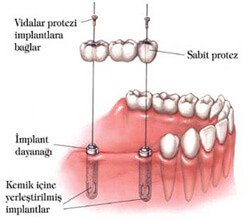Bridge
Oral Surgery » Bridge

A dental bridge is a false tooth or teeth which is fused between two porcelain crowns to fill in the area left by a missing tooth or teeth.
 A dental bridge consists of two or more crowns anchored on either side of a gap in the mouth, that is used to replace a missing tooth or several teeth. They are strong and reliable and are made to look and feel just like your natural teeth.
A dental bridge consists of two or more crowns anchored on either side of a gap in the mouth, that is used to replace a missing tooth or several teeth. They are strong and reliable and are made to look and feel just like your natural teeth.
A dental bridge is a false tooth or teeth, known as a pontic, which is fused between two porcelain crowns to fill in the area left by a missing tooth or teeth. The two crowns holding it in place that are attached onto your teeth on each side of the false tooth. This is known as a fixed bridge. This procedure is used to replace one or more missing teeth. Fixed bridges cannot be taken out of your mouth as you might do with removable partial dentures.
In areas of your mouth that are under less stress, such as your front teeth, a cantilever bridge may be used. Cantilever bridges are used when there are teeth on only one side of the open space. Bridges can reduce your risk of gum disease, help correct some bite issues and even improve your speech. Bridges require your commitment to serious oral hygiene, but will last as many ten years or more.
Types of dental bridge
There are three types of dental bridge: fixed, resin bonded, and cantilever. The type of bridge used will depend on the quality of the teeth on either side of the gap, as well as the position of the gap.
Fixed Bridges
With a fixed bridge, the false tooth, or pontic, is anchored to new crowns attached to the teeth either side of the gap. These crowns are usually made from porcelain with the new tooth made from either ceramic or porcelain. This forms a very strong bridge that can be used anywhere in the mouth.
Resin Bonded Bridges
Sometimes called Maryland Bonded, these dental bridges do not involve crowning the adjacent teeth, so are useful where these show little or no previous damage. The new tooth is generally made from plastic and is attached via metal bands bonded to the adjacent teeth using resin. This type of bridge is particularly suitable for front teeth where stress is minimal, and the bond can be made out of view behind the teeth.
Cantilever Bridges
These dental bridges are used where there is a healthy tooth only on one side of the gap. The bridge is anchored to one or more teeth on just one side. As a result, this type of bridge is generally only suitable for low stress bridges such as front teeth.
How your bridge is fitted?
It will take at least two visits to your dentist to have a dental bridge fitted and adjusted correctly. On your first visit preparatory work will be done, such as making space for new crowns for a fixed bridge. Your dentist will then take a mould of your teeth from which your bridge will be made. On your next visit, your bridge will be fitted and adjusted to ensure a correct bite. It is unlikely your dentist will permanently fix your bridge until you’ve worn it for a few weeks and are both happy with the fit and feel. It will then be fixed permanently into place.
Caring for a dental bridge
Even the best fitting bridge will still have gaps around and beneath it, and these can quickly accumulate damaging debris if you do not follow a strict hygiene regime. You should pay particular attention to the false tooth that forms the bridge, cleaning and flossing regularly. Extra care should also be given to the supporting teeth either side of the bridge, as without these, the bridge will fail.
There is a range of specially adapted tools to help you access the awkward areas around a bridge, and your dentist or hygienist will be happy to demonstrate these for you.
Alternatives to a dental bridge
The only alternatives to a dental bridge are dentures or implants. Single tooth dentures can be uncomfortable and awkward where only one or two teeth are involved, and are not generally recommended for this purpose. Dental implants involve having a false tooth fixed to a titanium post that has been screwed into the jawbone. This can be an expensive and invasive process and is only suitable to people who are medically fit, with healthy gums and thick jawbones.

